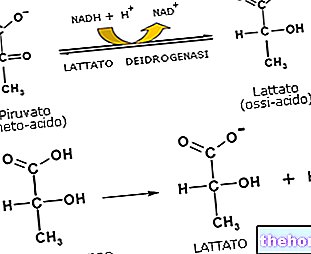What is lactacid anaerobic metabolism?
The anaerobic lactacid metabolism is a cellular "physiological mechanism" responsible for the production of energy, regardless of the use of oxygen and creatine-phosphate (CP); this energy system is in fact able to produce ATP (Adenosine Tri Phosphate) in an anaerobic environment by activating anaerobic GLYCOLYSIS (using glucose and NOT other substrates).
With the anaerobic lactacid metabolism, 2 molecules of ATP + LACTIC acid are obtained from a molecule of glucose; this differentiates it from ALATTACIDO anaerobic metabolism (which does NOT produce any metabolic "waste" starting from the CP).

What is the anaerobic lactacid metabolism used for?
The anaerobic lactacid metabolism is a "capacity" useful above all for the muscle contraction required by:
- Too rapid and immediately intense efforts that cannot be supported ONLY by aerobic metabolism. Eg: strength and resisting force (lifting of overloads for a time exceeding 10-15 seconds), speed and resistance at speed (terminal phase of a maximum stroke), any execution of force and speed with INCOMPLETE recoveries.
- Prolonged efforts but of an intensity above the anaerobic threshold. Eg: all aerobic activities that require one or more increases in the intensity of exercise: climbing or flying in cycling, middle distance running, rowing race pace, canoe race pace, etc.
Curiosity
The lactate anaerobic system takes place mainly in the cytosol of myocytes for muscle contraction, but not only: it is also typical of a few other cells that have to work without using oxygen, such as red blood cells.
Work out
There is a substantial difference between the activation of the anaerobic lactacid metabolism in conditions of NOT MASSIVELY ACTIVATED aerobic metabolism and in conditions of FULLY ACTIVATED aerobic metabolism.
The training that involves the stimulation of the anaerobic lactacid metabolism in the disciplines of strength and speed is based on the speed with which the muscle is able to produce energy and lactic acid; in this case, the LACTACID power is the most important capacity to develop and the activation or not of aerobic metabolism assumes an almost marginal role. In two words, performance depends more on the ability to deliver energy rather than on the AUTONOMY that this metabolism could allow; it is clear, in strength and speed activities there is also a very important anaerobic ALAttacida component (splitting of the CP), however, in itself it represents only a FRACTION of the athletic capacity (the more important the shorter the effort). The specific training is oriented ABOVE ALL towards the EFFECTIVENESS of the ANAerobic lactacid metabolism; therefore it foresees the execution of protocols focused on repetitions or repetitions of maximum intensity and likely characterized by medium or large recoveries.
On the contrary, the training that involves the stimulation of the anaerobic lactic acid metabolism in middle distance disciplines or in those that involve short but close rhythm variations / bursts, is based on the ability to produce energy and lactic acid above the endogenous disposal capacity , therefore beyond the anaerobic threshold, but in any case in conditions of significantly stressed or even maximal aerobiosis. While in the previous case the SYNERGIC lactacid metabolism was the anaerobic ALAttacido, now the component that most affects is the AEROBIC metabolism; the specific training will therefore be characterized by lower intensity levels than the previous one but with decidedly HIGHER duration and volume. The most used technique for stimulating the anaerobic lactacid metabolism above the threshold is to carry out tables in rhythm variation and / or repeated over distances sufficient to fully activate the aerobic metabolism as well; the intensity can be constant or progressive. The stimulus is oriented both on the EFFECTIVENESS of the anaerobic energy production and on the TOLERANCE and DISPOSAL of the lactate peaks. The recoveries can be more or less large, active or passive.
Improve lactate anaerobic metabolism with nutrition and supplements
To improve sports performance related to anaerobic lactacid metabolism, it is essential to carry out specific work above all; therefore, following the construction of a more or less important aerobic athletic base, the sportsman must begin to set the tables according to the duration of the competition effort and the concentrations of lactic acid to be produced.
In sports it is common to run into the advertising of food supplements "theoretically" useful for improving the anaerobic lactacid metabolism, but concretely their effectiveness is decidedly "relative"; however, if the athlete shows signs of chronic fatigue and difficulty in recovering between training sessions, it is possible that he can benefit from a saline supplement (especially magnesium -mg) useful for compensating for food deficiencies.
It should be clear that THERE ARE NO PRODUCTS ABLE TO MODIFY THE ENZYMATIC METABOLISM OF THE MUSCLE, but in the disciplines that expose the athlete to large variations of lactate it is possible that some alkalizing supplements (potassium citrate - potassium citrate) and / or bicarbonate can contribute to the "optimization of race performance. This happens thanks to a recovery of saline homeostasis or as a buffer effect of muscle acidity, but it is always and in any case INDIRECT and SUBJECTIVELY determined effects. Carnosine and one of its two precursor amino acids, Beta-alanine, have also shown excellent buffering properties against lactic acid.




























